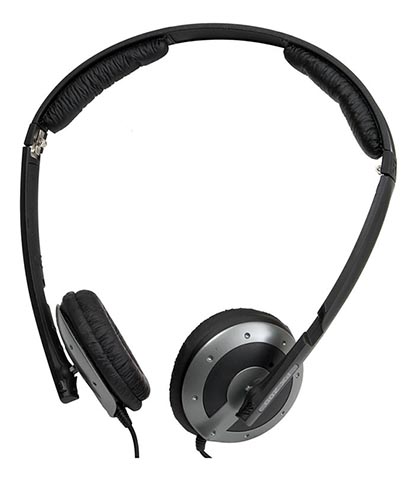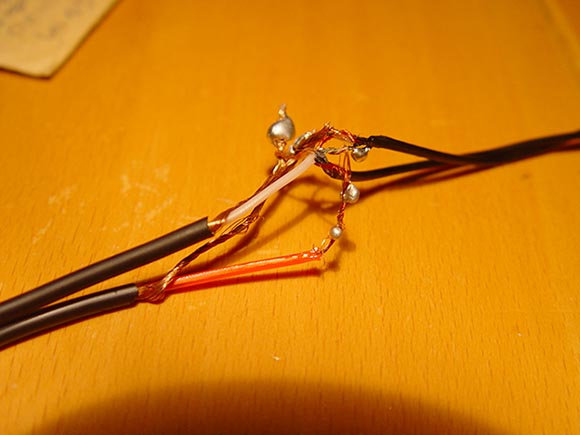I spend most of my day at my computer. I don’t have an hi-fi system in my living room. I consume all audio content via headphones. So naturally, I’m dependent on good headphones. After some experiments I found pair of Sennheiser headphones I really like. They are not earplugs but real headphones with some surprisingly descent noise isolation. Best of all, they are very compact too. They can be folded Transformers-style into a small plastic case and I can take them everywhere I go. They are premium headphones while still being portable.

PX200 – sorta awesome… as long as they work.
Unfortunately, they have a serious flaw. The audio connector on them causes some annoying problems. I admit it may have to do with the way I use them. I bought the same ones for my girlfriend and they work fine for her. But I had 3 pairs of those and each of the succumbed to a failure of the connector of some sorts. Usually they would develop a nasty loose contact and one of the channels wold work only intermittently.
Now granted, Sennheiser has some very good service. I sent in my first pair long after the initial warranty was over and they just sent me a new pair. That one lasted for around 3 years until it also started having problems. At this point the material also was rubbing off so I got me a third, brand new pair. It had a different connector so I had my hopes up. Unfortunately, that one also sorta broke just recently but in a different way. The cable slid out for a few millimeters out of the connector casing, exposing the wires. They would sometimes cross over and disturb the signal.
So I thought I try a different strategy and fix that damn connector. After all, the headphones are great, it’s just that stupid connector that is causing problems. I thought it was a good opportunity to get some soldering skills. I bought a soldering kit some time ago and didn’t even have the time to try it. So I got a bunch of replacement connectors sat down and… failed miserably.
The problem is that the headphones use a RALLY weird cable. I have never seen anything like this. Usually, you would have a two pieces of wire per channel, each one in some kind of insulator. When I cut open the cable in the headphones I found that each channel had two exposed wires with no visible insulator. Even better, within the wires I found strands of some sort of artificial fabric – probably nylon or something. So I started putting the wires on different part of the plugged-in connector to see which wire is which – it didn’t do anything. Very rarely I would get some static but never a clear signal. WTF?! Was this nylon some sort of super-new material transmitting the signal?
After at least two hours of experiments I finally got it. It turns out that each fiber of the wire is individually isolated with a super-thin layer of coat. I was able to remove some of that coating by scraping it off with the knife. But this causes some tremendous troubles. I had to crape that coat from each of the four wires individually. The procedure way very tricky. Scraping would often cut of individual fibers thinning the wire out until it was not much thicker than a hair. The nylon core also got in the way so I had to extract it and cut it off.
But then the soldering didn’t went well either. Normally you would heat the wire and simply put the solder on it. The hot wire would melt the solder and the liquid solder would spread itself on the wire. But that wasn’t really possible with such hair-thin wires. I had to heat the solder directly and let it drip onto the connector plates, which is always a mess. After a long fight I finally connected everything. I plugged it in and it simply didn’t work at all.
I got frustrated and wanted to see at least some kind of results. I took another cable with already a connector installed, I cut in in half, exposed the wires and soldered them onto the wires of the headphone. Again, that turned out to be also a pain in the ass because of the flimsy thin headphone wires but at least I got it to work.
The result is a mess. The soldering is horrible. Because of all the exposed wires it’s still got a loose contact. I even managed to melt the cable isolation with the soldering iron in some places. I can pretty much just throw away the whole thing. Good thing I started out with the old worn-out pair. I initially wanted to do the same procedure with the newer pair. I decided against it. Instead I put some epoxy on the exposed part of the new headphones and decided not to attempt any repairs on them ever again.
There is a lesson in there somewhere.







Google this ‘problem’ of soldering the above described wires. Article failed to answer my problem:). I simply do not know how they solder these wires. I have tried burning the ends of the wires to destroy the inner nylon support material but you are then left with burnt, sooty or oxidised conducters. Could be that alcohol (methylated spirits or isopropyl alcohol) may dissolve the lacquer on the ends of the cable, that’s if the ‘lacquer’ is shellac which is/was commonly used to insulate electrical wire.
If I come up with an answer, I’ll let everyone know. Truth is, it probably aint worth all the grief.
G>P>M>
Hi Krystian,
I had exactly the same problem. I was also thinking that some sort of chemical, or alcohol is the solution to removing the coating on the troublesome wires?
I saw a youtube video with instructions on removing the coating using fine sandpaper. I tried that, but on the px200, the wires are way too thin.
Anyone else come up with an easy solution? I’m keeping the broken headphones just in case this can be fixed in the future
Thanks for the post!
- Donovan
Same problem here on a 3.5mm to mini-XLR plug. No answer, but I saw someone mentioning Hydrochloric Acid for removal of the ‘nylon’. Haven’t tried it, but it sounds good. Of course, YMMV